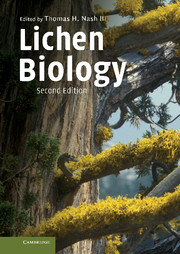Book contents
- Frontmatter
- Contents
- List of contributors
- Preface
- 1 Introduction
- 2 Photobionts
- 3 Mycobionts
- 4 Thallus morphology and anatomy
- 5 Morphogenesis
- 6 Sexual reproduction in lichen-forming ascomycetes
- 7 Biochemistry and secondary metabolites
- 8 Stress physiology and the symbiosis
- 9 Physiological ecology of carbon dioxide exchange
- 10 The carbon economy of lichens
- 11 Nitrogen, its metabolism and potential contribution to ecosystems
- 12 Nutrients, elemental accumulation, and mineral cycling
- 13 Individuals and populations of lichens
- 14 Environmental role of lichens
- 15 Lichen sensitivity to air pollution
- 16 Lichen biogeography
- 17 Systematics of lichenized fungi
- Appendix: Culture methods for lichens and lichen symbionts
- References
- Taxon index
- Subject index
11 - Nitrogen, its metabolism and potential contribution to ecosystems
Published online by Cambridge University Press: 05 September 2012
- Frontmatter
- Contents
- List of contributors
- Preface
- 1 Introduction
- 2 Photobionts
- 3 Mycobionts
- 4 Thallus morphology and anatomy
- 5 Morphogenesis
- 6 Sexual reproduction in lichen-forming ascomycetes
- 7 Biochemistry and secondary metabolites
- 8 Stress physiology and the symbiosis
- 9 Physiological ecology of carbon dioxide exchange
- 10 The carbon economy of lichens
- 11 Nitrogen, its metabolism and potential contribution to ecosystems
- 12 Nutrients, elemental accumulation, and mineral cycling
- 13 Individuals and populations of lichens
- 14 Environmental role of lichens
- 15 Lichen sensitivity to air pollution
- 16 Lichen biogeography
- 17 Systematics of lichenized fungi
- Appendix: Culture methods for lichens and lichen symbionts
- References
- Taxon index
- Subject index
Summary
Nitrogen is a macronutrient essential for life in the formation of proteins and nucleic acids. Its limited availability frequently constrains growth and productivity, both of individual organisms, such as lichens (Chapter 13 and Crittenden et al. 1994), and of ecosystems as a whole. On the other hand, nitrogen may also be present in excessive amounts in some regions, such as those affected by high deposition of ammonia associated with fertilizer use and/or animal husbandry. Because nitrogen is not part of the Earth's crust's material, rock weathering and subsequent soil formation do not provide a nitrogen source, as they do for many other elements. Rather the principal pool of nitrogen is atmospheric nitrogen N2, which is not readily utilized by most organisms. Nitrate (NO3−) and ammonia (NH3, or ammonium ions, NH4+) are the inorganic forms of nitrogen that are universally processed by organisms, and their availability is critical to growth and survival of green-algal lichens (Chapter 10). With chlorolichens, nitrogen concentrations can often be related to atmospheric deposition of these ions (Hyvärinen and Crittenden 1998a). At least some cyanolichens are part of the small group of organisms, including some bacteria and actinomycetes, capable of utilizing atmospheric N2 directly. As a result cyanolichens have higher total N concentrations (2.2–4.7%) than chlorolichens (0.4–0.85%) (Rai 1988). Because cyanolichens are abundant in a number of ecosystems, their potential contribution to nitrogen fixation in these ecosystems has led to attempts to quantify the rate of nitrogen fixation by these lichens and to understand the environmental and physiological factors limiting their fixation rates.
- Type
- Chapter
- Information
- Lichen Biology , pp. 216 - 233Publisher: Cambridge University PressPrint publication year: 2008
- 23
- Cited by

